Walking Down the Path of Intolerance
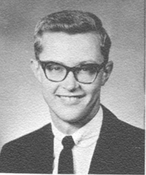
What Happens When Church Leaders Employ Strident Rhetoric Against Advocates of Equality?
For me, my fellow board members, and hundreds of Ordain Women supporters, our advocacy of ordination and equality within the LDS Church is an act of love toward our faith, our culture, and our heritage. We have attempted in every possible way to carry on a respectful and faithful dialogue with our church leaders.
Despite Ordain Women’s faithful and respectful tone, I have been disturbed in recent weeks by the harsh and divisive rhetoric employed by two church leaders toward their fellow saints, who express any disagreement with church policy. This harsh rhetoric is not Christ like, and potentially dangerous. I worry, because church leaders walked this same rhetorical path prior to 1978. Their failure to acknowledge the good will of those who argued in favor of racial equality in the church ultimately damaged the reputation of church.
In April Conference (2016), Dahlin H. Oaks spoke about “opposition.” In his speech he stated:
Some of this opposition even comes from Church members. Some who use personal reasoning or wisdom to resist prophetic direction give themselves a label borrowed from elected bodies—“the loyal opposition.” However appropriate for a democracy, there is no warrant for this concept in the government of God’s kingdom, where questions are honored but opposition is not (see Matthew 26:24).
While it is disturbing that loyal members are not be tolerated, when expressing an opinions differing from current church policy, even more ominous is the use of Matthew 26:24, as a reference. This passage reads: “The Son of man goeth as it is written of him: but woe unto that man by whom the Son of man is betrayed! it had been good for that man if he had not been born.”
This rhetoric is disturbing for two reasons. 1) It lack any proportionality. Does Elder Oaks seriously believe that anyone who disagrees with a church policy is betraying Christ, or that it would have been better if that person had never born? 2) Such rhetoric from an influential leader can lead to violence. A mentally unstable follower may interpret such rhetoric as a call for violence against others. Those of us, who advocate for equality in the church, have become all too familiar with hateful and sometimes threatening messages from unstable members of the church.
Falling in line with Elder Oaks, L. Whitney Clayton made these comments in his commencement speech at Brigham Young University on April 23, 2016. “The faithless often promote themselves as the wise who can rescue the rest of us from our naiveté. . . . We should disconnect immediately and completely from listening to the proselytizing efforts of those who have lost their faith . . .”
Leaders’ words have consequences. Words like these destroy families, break up friendships, and can even result in adverse business and employment consequences for members, who in good faith and after much thought and prayer have concluded that current church policy is incorrect. There have been times in the past, when members acting in good faith and following the dictates of their conscience have proven to be correct, and the church has changed its policies. Before ramping up the rhetoric, leaders might consider the damage caused by previous leaders in such situations. For example, leaders damaged the church, when they refused to acknowledge the injustice of the priesthood/temple ban against members of African descent. Instead, leaders mistakenly insisted that inequality was the will of God, and punished those who challenged this policy.
After years of unsuccessful requests to meet with church leaders, and after publically stating his opposition to the policy, my uncle Byron Marchant, was excommunicated in October 1977. However, the costs were much higher than his church membership, alone. He lost his employment, and after my aunt died on brain cancer during this same period, misguided relatives sued for custody, and took his two young daughters.
While Byron has never received an apology, in the recent official church essay on “Race and the Priesthood,” church leaders approved the following language:
Today, the Church disavows the theories advanced in the past that black skin is a sign of divine disfavor or curse, or that it reflects unrighteous actions in a premortal life; that mixed-race marriages are a sin; or that blacks or people of any other race or ethnicity are inferior in any way to anyone else. Church leaders today unequivocally condemn all racism, past and present, in any form.
What were these theories that the Church now disavows? What was the rhetoric that cost Bryon so dearly? Here are a few examples from church leaders of that time.
“There is a reason why one man is born black and with other disadvantages, while another is born white with great advantages. The reason is that we once had an estate before we came here, and were obedient; more or less, to the laws that were given us there. Those who were faithful in all things there received greater blessings here, and those who were not faithful received less” (Joseph Fielding Smith, Doctrines of Salvation 1:61. Italics in original).
“Surely no one of you who is an heir to a body of more favored lineage would knowingly intermarry with a race that would condemn your posterity to penalties that have been placed upon the seed of Cain by the judgments of God” (President Harold B. Lee, Decisions for Successful Living, p. 168).
“When He placed the mark upon Cain, He engaged in segregation. When he told Enoch not to preach the gospel to the descendants of Cain who were black, the Lord engaged in segregation. When He cursed the descendants of Cain as to the Priesthood, He engaged in segregation” (Mark E. Petersen, “Race Problems – as they affect the church,” August 27, 1954, p. 15).
“The arm of flesh may not approve nor understand why God has not bestowed the priesthood on women or the seed of Cain, but God’s ways are not man’s ways” (Ezra Taft Benson, Conference Reports, October 1967, p. 34).
Brethren, please be careful with your rhetoric. Please do not walk us down this dark path again. As supporters of Ordain Women, our belief in equality comes from our belief in the justice of God. We love our faith, our culture, and our heritage. We advocate for equality because of our desire to see the church we love improve and flourish. Our conviction is honest and deep. We hope that you will respect our sincerity and respond in good faith. We do not want to see the church that we love once again walk down the path of intolerance.
Ready for Revelation
Mark Barnes, the author of this post, is on Ordain Women’s Executive Board as Finance Committee Chair.
Reflections on Infertility
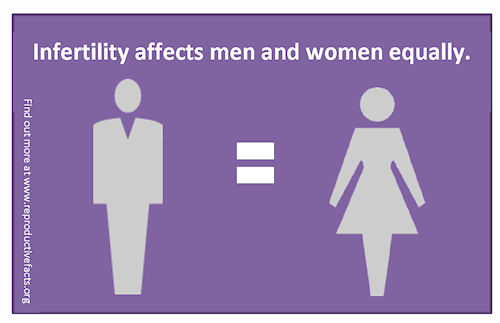
When I was 21, I gave birth to a son. My husband and I had tried for almost a year to get pregnant and were so grateful when we became parents. A year later, we decided it was time to have another child. This began a four-year ordeal of waiting and praying and sobbing at unexpected moments—I recall dissolving into tears when I accidentally watched a news story about babies wearing Dr. Seuss hats in the newborn ward at our local hospital—as doctors informed us that our first child was likely going to be our only child.
Infertility is a painful experience that cannot be adequately described. There are no words for the loss of a dream; a future you had imagined now lost. For Mormon women, this pain can be spiritual as well. I recall countless lessons, talks, and activities that broke my heart as they reminded me that my purpose in the church and as a daughter of God was to bear children. Among other folk doctrines, we have been told by our leaders that:
- Motherhood is our most essential role and that “it is the essence of who we are as women.”
- Women are called as mothers, trusted by Heavenly Parents to raise precious spirits here on earth.
- Women enjoy the privileges of pregnancy and childbirth, so men alone should enjoy the privilege of blessing and baptizing those children.
- Sisters in our faith are not ordained to priesthood office on earth because motherhood is the equivalent of priesthood.
Women in our faith community are reduced to the biological ability to conceive. Many of us find this painful and, frankly, offensive. We are valuable because we are daughters of Heavenly Parents who love us. We have individual worth and divine nature, unique to our own spirit. We can gain knowledge and act with integrity. We are people, not vessels.
This week, April 24-30, is Infertility Awareness Week in the US. Please take a moment to think about the way we have pushed women who are not mothers to the periphery of our faith. I have felt this personally, even believing that my infertility was somehow evidence that I was not worthy of being a mother. It took years for me to realize that this was not the case: my individual worth is not dependent on my ability to procreate. In an effort to justify gender inequality, we have created a caste system for women and made so many of our sisters feel untrusted, unrighteous, and unworthy.
My own journey took an unexpected turn, when after five years we discovered that we were expecting another child. And three years after that, a third child came into our family. I have no explanation for why my fertility challenges ended. I know that it has nothing to do with my Heavenly Parents loving or trusting me enough to raise Their spirit children. I know that during our struggles, my husband never felt that his priesthood office somehow made up our struggle. And I do know that fatherhood is the equivalent of motherhood and any other false equivalency will only serve to further marginalize women in our faith.
Ready for Revelation
Debra Jenson, The author of this post, is Ordain Women’s Communications Committee Chair.
Knock and It Shall be Opened Unto You
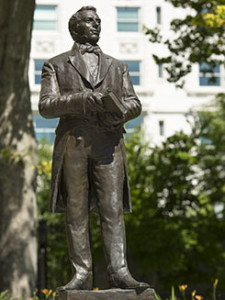 Joseph Smith was an accessible prophet by most accounts. The Saints called him Brother Joseph, and he invited them into his home and his life and his family (I know there is a polygamy joke to be made here, but let’s set that aside). Our church’s early history is full of stories about the people he and Emma sheltered, counseled, and cared for. No evidence is more compelling, in my mind, than the Doctrine and Covenants. This sacred text is full of revelations that Joseph Smith received at the request of members of the church. The section headings in the Doctrine and Covenants tell us that Brother Joseph commonly went to the Lord with questions from men like Martin Harris, Oliver Cowdery, Joseph Knight, the Whitmer brothers, and many others. He even went to the Lord on behalf of William E. McLellin when McLellin wouldn’t tell him what his questions actually were (see Section 66). Sometimes the concerns were more communal and when a lot of people wanted the Lord’s guidance (some examples are Sections 43 and 58). Sometimes the concerns were more general like, “What is the Lord’s will for me?” Sometimes it was more specific like when Edward Patridge wanted instruction from the Lord about settling the Saints in Ohio (see Section 51). And let’s not forget what happened when Emma Smith wanted to not be cleaning tobacco off the floor anymore (see Section 89).
Joseph Smith was an accessible prophet by most accounts. The Saints called him Brother Joseph, and he invited them into his home and his life and his family (I know there is a polygamy joke to be made here, but let’s set that aside). Our church’s early history is full of stories about the people he and Emma sheltered, counseled, and cared for. No evidence is more compelling, in my mind, than the Doctrine and Covenants. This sacred text is full of revelations that Joseph Smith received at the request of members of the church. The section headings in the Doctrine and Covenants tell us that Brother Joseph commonly went to the Lord with questions from men like Martin Harris, Oliver Cowdery, Joseph Knight, the Whitmer brothers, and many others. He even went to the Lord on behalf of William E. McLellin when McLellin wouldn’t tell him what his questions actually were (see Section 66). Sometimes the concerns were more communal and when a lot of people wanted the Lord’s guidance (some examples are Sections 43 and 58). Sometimes the concerns were more general like, “What is the Lord’s will for me?” Sometimes it was more specific like when Edward Patridge wanted instruction from the Lord about settling the Saints in Ohio (see Section 51). And let’s not forget what happened when Emma Smith wanted to not be cleaning tobacco off the floor anymore (see Section 89).
The truth is, most of what is in the Doctrine and Covenants is there because Joseph Smith saw himself as an intermediary between the people and the Lord. When they came to him, he was there for them and he went to the Lord for them.
It seems like this open-door policy existed between church leaders and church members for a long time. I think the relationship has become more strained over the years. I know people who will tell stories from their childhoods in Utah, where they made cards and wrote letters to the First Presidency and Apostles and hand-delivered them to these men’s offices. They don’t allow that anymore. But even just a couple of years ago, the Let Women Pray campaign organizers successfully hand-delivered their letters to the Church Administration building.
But now the doors are closed.
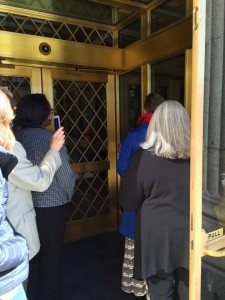
I submit that they should not be. I long for the environment of the early saints when members of the church could approach their leaders with questions and with a desire to know—directly and specifically—the Lord’s will for them. I am hungry for this kind of communication with my Heavenly Parents, with Their prophet as the intermediary. Priesthood, in particular, is a murky area of doctrine, and female ordination is even more so. I need a lot of clarification. Women’s participation at church and in the church’s hierarchy poses a lot of questions for me. I am Ready for Revelation about these issues. It is heartbreaking that they won’t open the door to even hear our questions.
Inequality = Abuse
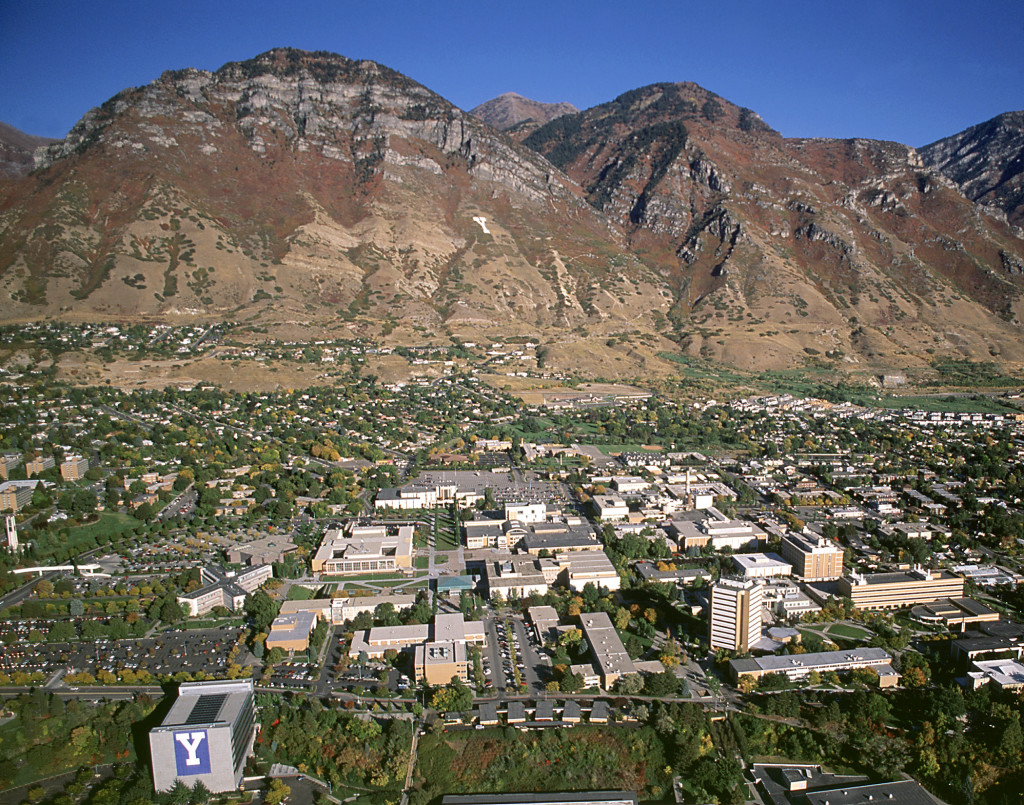
Aerial view of the campus of Brigham Young University in Provo, Utah.
Photo by Mark A. Philbrick
I have been deeply troubled by reports that BYU used a stolen police report from a rape case as the basis for an honor code investigation against the victim. After an enormous amount of public pressure, BYU announced that they will “study” the situation. BYU’s deplorable actions are a symptom of the systemic inequality found in the church. Until we end the inequality, we cannot hope to end the abuse we see in LDS homes, wards, and educational institutions like BYU. The inequality of an all male priesthood inherently creates abuse against women.
In 1954, the United States Supreme Court tapped into an eternal truth. In Brown v. Board of Education of Topeka, 347 U.S. 483 (1954), the Court rejected arguments that reform of the current segregation system could be sufficient. The Court found that “separate” was inherently unequal, and explained that segregation causes minority children to see themselves as inferior.
The Court stated: “To separate them from others of similar age and qualifications solely because of their race generates a feeling of inferiority as to their status in the community that may affect their hearts and minds in a way unlikely ever to be undone.”
The all male priesthood is a form of segregation. From the age of twelve, girls are separated from boys in the church. The message of female inferiority is unmistakable. Boys are given power and responsibility. They are trained to be leaders, while girls are taught to be submissive.
At home, a girl is told that her father is the head of her household, or if there is no father in the home, that her home is inferior because it lacks priesthood. On any given Sunday, a girl looks up at the stand and sees only men in positions of power and leadership. This same lesson is delivered even more dramatically every April and October, as she sees only men as leaders, and is told that it is only men who speak with God, at least in any meaningful way within the church.
Boys in the church also receive these same lessons. Even if benevolent, they are taught to see women are inferior. Boys are taught that their feeling matter. When they grow up and have families, boys learn that their thoughts and desires carry weight, while women’s thought and desires should yield.
My experience as a male ally has been an education. I have heard endless stories of abuse within the context of my religion. I have heard countless stories of men feeling that it is their right to impose their will in their homes. I have heard the pain and anguish that this creates. I have seen women called into countless meetings with local leaders, who demand that they submit and accept their “roles as women.” I have also seen members of the church write endless messages to the women of OW demanding conformity to the system. At times the pressure on the women of OW is relentless. In contrast, as a man, I rarely receive pushback at all for my active involvement in Ordain Women.
The inequality in the church fosters the myth of male superiority. No matter how much lip service is given to the “righteous exercise of authority,” this inequality is inherently damaging and abusive. As a result, I was not surprised to hear that officials at BYU willingly received a police report, which was improperly (if not illegally) delivered to them, and used it as the basis to investigate the female victim of a sexual assault for honor code violations. After all, they have been immersed in the myth of male supremacy, and believe in the idea that men have a right to enforce female conformity, even in the context of sexual assault.
Ready for Revelation
Mark Barnes, the author of this post, is on Ordain Women’s Executive Board as Finance Chair.
Remembering “for and on Behalf of”
The horrifying discovery that Mormon founding mother and proto-feminist Eliza R. Snow was repeatedly sexually assaulted brought attention to the problematic aspects of sexuality in Mormonism. This finding is especially striking in the context of polygamy during the notoriously uptight Victorian era. Imagine enduring and surviving this experience in secrecy, and only recorded as dark whispered conversations among trusted women around kitchen tables. No counselors, no rape kits, no police reports, no justice, – that was the reality of women’s sexual vulnerabilities until fairly recently.
As tragic as Sister Snow’s experience was, contemporary accounts often ignored the parallel reality of women of color in the 19th century. Native American and African-American women were not even considered as legally human at the time; in post-Civil War America, the frustrated promises of the Reconstruction era still left African-American women with the same vulnerabilities, and the systematic forced displacement of the entire Native American nations further erased the presence of women of color. We will never know how many women of color, often considered public property, were victims of sexual violence. The few stories we have, again handed down as whispered conversations, are only hints at a broader context where women of color were fair game for predators.
Even now, the repercussions still linger. Because of interlocking and overlapping legal structures, Native American women experience high rates of rape and sexual assault with little recourse. The Mormon church is not immune; recently two Navajo siblings filed suit alleging that the church did nothing to stop sexual abuse while they were placed in a church program for Native American children. Given the church’s own checkered history on addressing sexual abuse and racism, one can imagine the multiple layers of secrecy and shame when a Mormon person of color is subjected to sexual assault.
We will never know how many nameless, invisible, non-white women, then and now, who underwent the same fate as Sister Snow. We can only guess – and remember, “for and on behalf of.”
Announcing the New Chair of our Executive Board: Bryndis Roberts
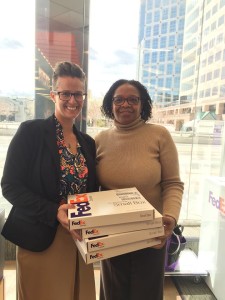
In my three years involved with Ordain Women, one of the greatest gifts is that I have met many wonderful people. I have made friends who mean enough to me that today I cannot imagine my life without them. They have challenged my thinking, taught me bravery, and inspired me with their faith. It has been a blessing.
As I count these blessings, one of those I cherish most is Bryndis Roberts. She and I have worked together on the Ordain Women board for more than a year and in that time, she has shown patience, love, and grace. I can always count on her to take time to work through a problem. I have never doubted her faith and devotion to the gospel of Jesus Christ and the children of our Heavenly Parents. And she has generously given her wisdom, insight, and support.
For these reasons and countless more, I am so pleased to see her take the helm as chair of the executive board for Ordain Women. After 18 months serving in this position, I can testify that it is demanding and heartbreaking, inspiring and exhausting. I have no doubt that Bryndis will rise to the challenge. And that she will then rise above it.
Please take a moment to meet Bryndis and then send a prayer to our Heavenly Parents on her behalf as she embarks on this new journey!
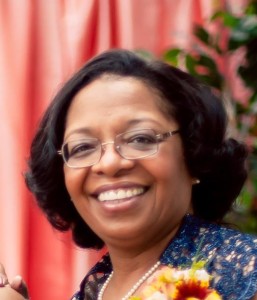 Bryndis Roberts is a proud alumna of Wesleyan College, Macon, Georgia, the oldest college in the world chartered to grant degrees to women.
Bryndis Roberts is a proud alumna of Wesleyan College, Macon, Georgia, the oldest college in the world chartered to grant degrees to women.
She was raised in the Black Baptist faith tradition and joined the LDS Church in January 2008. She has served as a Family History Consultant, Relief Society Teacher, Relief Society Second Counselor, Relief Society President, and Ward Welfare Specialist.
She is an attorney and has her own firm – Jenkins & Roberts LLC – where her law partner is her ex-husband, William Jenkins, who also happens to be her best friend. She is the mother of two strong, intelligent, and beautiful daughters, Jennifer Jenkins and Jessica Fay.
She is a lifelong Democrat and gladly accepts the labels of liberal and/or progressive. She is an active and vocal champion of voting rights and women’s reproductive freedom.
She is passionately interested in genealogy and her favorite vacation spots are any locations where there are lighthouses.
She joined the Ordain Women Executive Board in the fall of 2014. As she wrote in her profile: “As important as the work is, [she] cannot believe that it is the divine will that so many workers are not allowed to participate, fully and equally.”
Defying the Hammers of Conformity: The Brave Women Who Stand for Equality in the Church
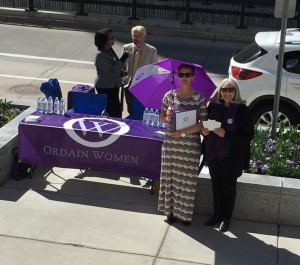
As a new missionary in Japan, I first heard the saying: “The nail that sticks up gets hammered down.” I naively thought that this saying uniquely applied to Japanese culture, but standing there in my white shirt and dark suit, I failed to see the hammers that smash away at nonconformity in my own Mormon culture. Among these hammers are claims of authority, threats, shame, shunning and isolation. Defying these hammers takes a tremendous amount of courage and strength. From April 1st to April 4th, I was privileged to stand with four women who serve on the Ordain Women Executive Board. I stood in front of the Church Administration Building with Joanna Smith, Bryndis Roberts, Debra Jensen, and Lorie Winder. We also had other strong supporters stop by and spent time with us. I was able to see first-hand strength and courage that is all too rare in our conformist culture.
The Church Administration Building is the center of power in the LDS Church. It contains the offices of the First Presidency and Quorum of the Twelve Apostles. As you can see in the pictures accompanying this post, we spent four 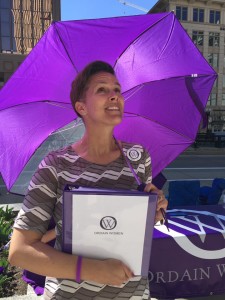 days dead center in front of this building, with the Ordain Women banner draped over our table. Church leaders refused to take the hundreds of postcards, which our group, lead by Debra Jensen, attempted to deliver the first day we stood.
days dead center in front of this building, with the Ordain Women banner draped over our table. Church leaders refused to take the hundreds of postcards, which our group, lead by Debra Jensen, attempted to deliver the first day we stood.
The postcards contained messages from supporters, who believe that women are “Ready to Witness.” They asked that women be able to witness baptisms, baby blessings, sealings, and highly personal interviews by male leaders of women and girls. Prior to our delivery attempt Friday morning, Debra Jensen sent a letter informing church leaders that a refusal to accept the postcards would result in our standing in front of their building until Monday morning when we would again try. Despite claims that the building was empty, we frequently saw drapes and blinds part, and eyes briefly stare out at us. We even received a friendly wave from a woman parting the drapes at the west end of the first floor. Monday morning, Bryndis Roberts lead our group up the stairs again, to try to deliver the postcards. Once again we were refused.
We also attempted delivery at the Relief Society building. Initially, we were asked if we would like to meet with Relief Society leaders. But, once the staff discovered we were with Ordain Women, we were told that everyone was out of town. The contrast was striking between the brave women standing in front to the seat of Mormon power and leaders, who hide behind layers of security, peek through the blinds in their offices, or who direct their staff to claim that they are suddenly out of town.
The price I have paid for my involvement in Ordain Women has been relatively small. I have a supportive family, and church leaders who leave me alone. Male privilege seems to repel most personal attacks. But, this is not the experience of many Ordain Women leaders and supporters. Many have felt the full force of the conformity hammers in their lives. This is my tribute to all in Ordain Women who have paid the price for doing what is right. They stand strong for female ordination and equality in the Church. I admire the strength and bravery I see every day in Ordain Women. I am proud to be a part of this organization.
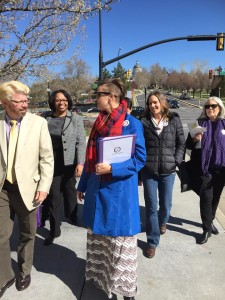
We Remain Ready to Witness
We were spiritually prepared:
In addition to our individual prayers and meditations, we came together for a devotional in which we sang inspirational songs and invoked the presence of the Spirit.
We were physically prepared:
We had water to stay hydrated. We scheduled times for lunch breaks. We had chairs for those who needed to rest for a few minutes. We had umbrellas to shield us from the sun and coats to keep us warm.
We were respectful:
We approached the building politely and in a very orderly fashion. We remained in the area where our permit from Salt Lake City allowed us to be. We did not obstruct traffic on the sidewalk. We did not create a disturbance. We did not leave any litter or damage any flowers or greenery.
YET, WE WERE STILL REJECTED!
On Friday, April 1, we began the in-person portion of the #ReadytoWitness campaign with a devotional at City Creek Park. After the devotional, we walked the short distance from City Creek Park to the Church Administration Building.
Park. After the devotional, we walked the short distance from City Creek Park to the Church Administration Building.
We then made our first attempt to deliver the cards and letters (Click HERE to see the video). We mounted the steps of the Church Administration Building with feelings of trepidation, hope, and even a little fear. We were not allowed beyond the foyer and Debra Jenson, our Board Chair, who was our spokesperson, was told, over the white telephone that is used to speak to the security desk, that the Church does not accept hand delivery of packages. When she replied that we did not have a package but we had cards and letters, she was told that we would have to mail them. She told them we would be outside (right in front of the building) until 5:00 p.m. in case a Church leader or an authorized assistant was willing to accept our cards and letters.
 We stayed outside the building until after 5:00 p.m. on April 1. Despite the fact that all of the windows were covered by blinds and/or curtains, we could tell that there were people inside. At several points, people actually looked through the blinds or around the curtains at us, but no one came out to speak to us or to accept our cards and letters. We watched, in amazement, as several General and Area Authorities mounted the steps to the Church Administration Building, entered the foyer, used the security phone, and were not allowed to enter. Apparently, our leaders decided that since they did not intend to allow us to enter the building, it would look better if they did not allow anyone to enter the building (at least not through the front door).
We stayed outside the building until after 5:00 p.m. on April 1. Despite the fact that all of the windows were covered by blinds and/or curtains, we could tell that there were people inside. At several points, people actually looked through the blinds or around the curtains at us, but no one came out to speak to us or to accept our cards and letters. We watched, in amazement, as several General and Area Authorities mounted the steps to the Church Administration Building, entered the foyer, used the security phone, and were not allowed to enter. Apparently, our leaders decided that since they did not intend to allow us to enter the building, it would look better if they did not allow anyone to enter the building (at least not through the front door).
We were back in front of the building by 9:00 a.m. on Saturday, April 2, and stayed there until after 5:00 p.m. We did the same thing on Sunday, April 3. Again, there were people in the building. Again, some of them looked through the blinds or around the curtains at us. However, no one came out to speak to us or to accept our cards and letters and, again, Church officials who clearly expected to be able to enter the building were routed to other entrances.
We then returned on Monday, April 4, and made another attempt to enter the Church Administration Building and deliver the cards and letters (Click HERE to see the video). On that attempt I, in my role as Board Chair-elect, was the spokesperson, only to be told the same thing that had been told to us on Friday. We then tried to deliver the cards and letters to the Relief Society Building, where it seemed as though we would be allowed to meet with one of the assistants to a member of the Relief Society General Presidency, at least up until the moment we told her we were with Ordain Women.
BUT, THAT REJECTION WAS NOT THE END OF THE STORY!
As we stood outside the Church Administration Building over a three day period, we had the opportunity to interact with hundreds of our fellow Mormons who were attending General Conference and a large number of non-Mormons who either visiting Salt Lake City or going about their daily routines. We collected more cards and letters to add to our notebook. We talked with people who were supportive of our efforts and we talked with people who were not so supportive of our efforts. We handed out water bottles and we passed out treats.
While there were people who viewed us with disdain and dislike, we could see in the faces of other people that we were dispelling some of the misconceptions that they had about who we were and our feelings towards the LDS Church and Church leaders. Over and over again, we were asked if we were Mormons and when we replied in the affirmative, we saw looks of surprise on the faces of those who had asked the question.
We were blessed with tender mercies in the form of people who returned our greetings with the same love and kindness with which we extended them. Moreover, at every point when we were feeling discouraged there was always someone who stopped or turned around and came back to give us encouraging words and (more often than not) to take some of our buttons, pins, and bracelets, etc.
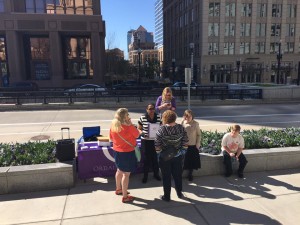
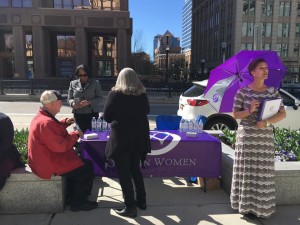
Because our Church leaders would not accept the cards and letters from us, we had the originals delivered to the First Presidency via Federal Express. We had copies delivered to the Relief Society General Presidency, the Presiding Bishopric, and the registered agent for service for the Corporation of The President of The Church of Jesus Christ of Latter-day Saints, also via Federal Express. We have received confirmation that those deliveries were made Thursday, April 7th.

To all of the women, men, girls, and boys who shared your stories with us, we say thank you for sharing and for entrusting us with your personal and precious testimonies. As we wrote in our letter in the Salt Lake Tribune:
It is our fervent hope and prayer that [the] messages [in the cards and letters] will be in the minds of our church leaders as they pray and seek revelation about ordaining women to the priesthood in the LDS Church.
Mis abuelas, mi mama y yo.
A veces me pregunto si mis abuelas estarían de acuerdo con mi vida si estuvieran aún con vida. No me mal interpreten, tengo una buena vida, pero no es del tipo de vida que mis creo que mis abuelas hubieran pensado para mí, o para cualquier otra de sus mujeres descendientes. Mi mamá, que aún vive, no aprueba algunas de mis elecciones de vida, pero ella es mi mamá y por el momento no he hecho algo que merezca que me desherede. (Aunque tengo que decirlo, estuvo a punto de hacerlo cuando me uní a Ordenen a las Mujeres).
Marzo es el mes de la Historia de las Mujeres. En parte por eso he estado reflexionando en la historia de estas tres mujeres de mi familia. Durante algunos párrafos que nunca reflejaran la complejidad de sus vidas, quiero compartir un poco de cada una de ellas.
Mi abuela maternal, Petra María Rodríguez Hernández, nació en 1918 y creció en un pueblo minero a las afueras de Monterrey, México. Ella fue una de 12 hijos y sólo 4 sobrevivieron la niñez. El quehacer de la casa estaba sobre la educación, razón por la cual ella sólo cursó hasta el cuarto año de primaria. Se mudó a la ciudad a sus veinte años trabajando como telefonista y costurera, lo que ayudó económicamente a sus padres y a su hermana enferma. Sirvió una misión mormona en Tampico, donde conoció a su esposo, un trabajador agrícola, ferrocarrilero y carpintero. Ella y mi abuelo se mudaron a Tijuana y comenzaron una familia. Mi abuela se quedó en casa para cuidar a sus dos hijas y tratando de ganar un dinero extra rentaba un cuarto a misioneros mormones. La familia emigró al sur de California en 1968, mi abuela seguía al cuidado de sus hijas y sus nietos. Ayudaba a la familia con su trabajo como costurera en la tintorería de su hermano. Mi abuelita Petra no soportó un ataque al corazón cuando yo tenía cinco años. Tengo pocos recuerdos de ella, incluyendo uno cuando ella me ayudaba a leer y escribir en un libro de Español.
Mi abuela paterna, Hermilia Alvarado, nació en Pedrizena, Durango, México en 1921. Ella fue la hija mayor de tres. Los detalles de su niñez son escasos, pero de lo que sabemos es que fue a la escuela y recibió capacitación para ser una excelente costurera. Mi padre recuerda que ella y el abuelo se conocieron a los 18 cuando él la contrató en su perfumería. La familia vivió en la Ciudad de México, después en Tijuana y luego en Ensenada donde mi padre nación. Después de casarse, ella llenó por completo el rol de ama de casa- de hecho la idea de trabajar era despreciable para mi abuelo. La familia después de un tiempo se regresó a Tijuana. Inclusive después de la muerte de mi abuelo, mi abuela crio a tres de sus nietos hasta la adolescencia, padeciendo de un progreso lento de Parkinson. Mi abuelita Hermilia tuvo una gran huella en mi vida. Mi padre la visitaba cada mes en Tijuana para llevarle dinero y mandado, y mi madre y mis hermanos lo acompañábamos muy a menudo. Yo recuerdo pasar semanas en el verano con ella y mis primos. Aún atesoro el álbum de fotos que hizo para mí con sus manos temblorosas.
Mi mamá emigró al sur de California con su hermana y padres a los doce años. A pesar de lo difícil que fue adaptarse a un nuevo ambiente e idioma, a mi mamá le fue muy bien en la escuela y se graduó de la preparatoria con un promedio impresionante. Muchas de sus maestras y consejeros le animaron a ir a la Universidad, pero ella tenía sus esperanzas en el matrimonio y en la vida de familia. A los 19 años se casó con mi padre y empezaron una familia, que consiste en cuatro hijos y yo. Una década después, cuando mi padre tuvo dificultades de mantener a la familia y pasando por varios trabajos, mi mamá regresó a la escuela y obtuvo un título de Maestra de Primaria. Recuerdo haberla acompañado a sus clases en la Universidad, mientras yo hacía mi tarea en silencio o leyendo mientras ella tomaba clases- pero también, por seguro, de inconscientemente aprender la pasión y el valor de una educación superior. Ella desde entonces ha tenido una carrera exitosa como educadora, siendo de los mejores promedios hasta convertirse en una capacitadora de otros maestros.
Como resultado de la vida de estas tres mujeres y de sus decisiones, aquí me encuentro. Por alguna razón, creo que tengo en mis genes una buena dote de ambición en comparación con mis hermanos. Después de una niñez estable, donde una buena parte la pasé compitiendo por tener superioridad moral y el control del Nintendo para mis cuatro hermanos, pasé casi todos mis veintes y principios de mis treintas siguiendo mi educación y entrenamiento para convertirme en una doctora. Tal vez todos esos veranos que pasé ayudando a mi mamá en el salón del kínder influyeron en mi decisión en especializarme en Pediatría. Ahora paso casi todos mis días poniendo en práctica mi educación en una clínica comunitaria muy socorrida (sin mencionar que también tratando de pagar mis créditos de estudiante). Tengo 13 años de feliz matrimonio y yo junto a mi esposo hemos decidido no tener hijos. En lugar de niños, nuestro hogar está lleno de conejos rescatados- sí, conejos- que con sus brinquitos hacen que el estrés de un día largo de trabajo se desvanezca. He sido vegetariana por más de una década por motivos éticos y de salud, una práctica que significa que rechazo alguno de los platillos favoritos de mi familia, mi cultura. Incluyendo el platillo favorito de mi abuelita Petra, los chiles rellenos de carne de res. En mi vida religiosa, apoyo de forma tranquila la ordenación de las mujeres al sacerdocio en el Mormonismo, porque (irónicamente a través del Mormonismo) he aprendido que Dios desea igualdad de oportunidades para todos.
Es importante para mi reconocer como las cosas cambian en el lapso de pocas décadas. ¿Cómo es que en mi amplia complejidad, surgí de la historia de estas tres mujeres? Y si algún día tengo una hija, ¿Cómo continuaría este linaje materno en su vida?
Así que, ¿qué pensarían mis abuelas de mi vida? Con toda honestidad, no estoy segura, pero las imagino lamentándose en varias formas de la elección de mi profesión, de que no tengo hijos, de mis decisiones alimenticias y de mi insistencia de seguir siendo mormona pero bajo mis propios términos. Recientemente, mientras hablaba con mi mamá sobre mi abuela, mi mamá dijo: “Cuando regresaba de la escuela podía escuchar la voz de mi mamá preguntando por qué no me había quedado en casa con mis hijos”. Así que cuando me pregunto sobre la aprobación de estas mujeres fuertes a mi vida , tengo que recordarme a mi misma que todos quienes tienen una mamá o una abuela- en otras palabras, todas, incluyendo a las abuelitas Petra y Hermilia- han sentido un poco de desaprobación por parte de sus madres. En mi imaginación también trato de decirle a mis abuelitas que sí estoy cuidando niños- un gran número de ellos, de hecho.
My Grandmothers, My Mother, and Me
I sometimes wonder whether my grandmothers would disapprove of my life if they were still alive to witness it. Don’t get me wrong, I have a pretty great life, but it is not the kind of life I think my grandmothers envisioned for me, or for any female descendant, really. My mother, who is alive today, certainly doesn’t approve of all of the choices I’ve made in life, but she’s my mother, and so far I haven’t done anything so egregious as to warrant her disowning of me. (I have to say, though, I’m treading awfully close to the line with Ordain Women.)
March is Women’s History Month. In part because of that fact, I have been reflecting on the history of these three women in my family. Although a few paragraphs could never encompass the full complexity of their lives, I want to share a little about each of them.
My maternal grandmother, Petra Maria Rodriguez Hernandez, was born in 1918 and grew up in a mining town on the outskirts of Monterrey, Mexico. She was one of twelve children, only four of whom survived childhood. Household chores took precedence over education, which is why she completed her education only through about fourth grade. She moved to the city in her twenties, where she helped support her parents and sickly younger sister as a switchboard operator and seamstress. She served an LDS mission in Tampico, where she met her husband, a field laborer, rail worker, and carpenter. She and my grandfather moved to Tijuana and started a family. My grandmother stayed home to care for her two daughters, but also tried to earn extra money by providing room and board for LDS missionaries. The family immigrated to southern California in 1968, where my grandmother continued to care for her daughters, and then her grandchildren. She helped support the family by doing clothing alterations at her brother’s dry cleaning business. My abuelita Petra succumbed to a heart attack when I was five. I have only a few memories of her, including one of her helping me learn to read and write in a little Spanish workbook.
My paternal grandmother, Hermila Alvarado, was born in Pedrizena, Durango, Mexico, in 1921. She was the oldest of three children. The details of her childhood are sparse, but I know that she attended school and received training to become a superb seamstress. My father recounts that she met my grandfather at age 18 when he hired her at his perfume store. The family lived in Mexico City, then Tijuana, then Ensenada where my father was born. After marrying, she filled her expected role of ama de casa – in fact, the very idea of her working was distasteful to my grandpa. The family eventually moved back to Tijuana. Even after my grandfather’s passing, my grandmother raised three of her grandchildren through adolescence, even though her later years were plagued by the slow advance of Parkinson’s disease. My abuelita Hermila was a larger presence in my life. My father would visit her in Tijuana monthly to take her money and groceries, and my mother, siblings, and I would often accompany him. I remember spending weeks at a time during summer vacation with her and my cousins. I cherish the wedding album she lovingly crafted for me with trembling hands a few years before her passing.
My mother immigrated to southern California with her sister and parents at the age of twelve. Despite the challenges of adapting to a new environment and language, my mother did very well in school and graduated from high school with an impressive GPA. Many of her teachers and counselors encouraged her to enroll in college, but she had her sights set on marriage and family life. At the age of 19 she married my father and proceeded to start a family, which ultimately consisted of four boys and me. About a decade later, when my father struggled to support the family through various jobs, my mother went back to school, eventually earning a B.A. to become an elementary school teacher. I remember accompanying her to her evening classes at the local community college and university, quietly working on my own homework or reading during the class – but also, surely, unconsciously learning the excitement and value of higher education. She has since had a successful career in early childhood education, rising through the ranks to become a literacy coach to other teachers.
Largely as a result of these three women’s lives and choices, I ended up here today. For some reason, I think I got a disproportionately large share of ambition genes compared to my siblings. After a less-than-indulgent but remarkably stable childhood, part of which was spent battling for moral superiority and Nintendo controller time with my four brothers, I spent all of my twenties and the early part of my thirties pursuing the education and training to become a physician. Maybe all of those summer days spent helping my mother in her kindergarten classroom influenced my own decision to specialize in pediatrics. I now spend most of my days putting my education and training to use in a busy community clinic (not to mention trying to pay off my student loans). I have been happily married for thirteen years, though my spouse and I have not yet chosen to start a family. Instead of children, our home is filled with rescued rabbits – yes, rabbits – whose “binky” hops in the evening somehow make the stress of a long day at work melt away. I have been a vegetarian for over a decade for both ethical and health reasons, a practice which means I reject some of the staples and favorite dishes of my own family and culture, including abuelita Petra’s favorite beef-filled chiles rellenos. In my religious life, I quietly advocate for the ordination of women in Mormonism, because (ironically, through Mormonism) I have come to believe in a God that desires equal opportunities for all of us.
It’s remarkable to me how drastically things can change in the matter of a few decades. How did I, in all my quirky complexity, emerge from these three women’s histories? And, if I someday have a daughter, how will her life continue to weave this maternal lineage?
So, what would my grandmothers think of my life today? In all honesty, I’m not completely sure, but I imagine them lamenting to various degrees over my choice of career, my childlessness, my unconventional dietary choices, and my insistence on being Mormon on my own terms. Recently, while speaking to my mother about her mother, my mother recalled: “When I went back to school I could hear my mom’s voice in my head asking ‘Why aren’t you staying home taking care of the kids?’” So when I imagine these strong women giving my life the once-over, I have to remind myself that anybody who has had a mother or grandmother – in other words, anybody, including abuelitas Petra and Hermilia – has probably felt some degree of matrilineal disapproval. In my imagination I also try to point out to my abuelitas that I am taking care of children – a whole community of them, if fact.










